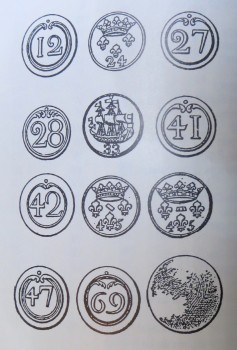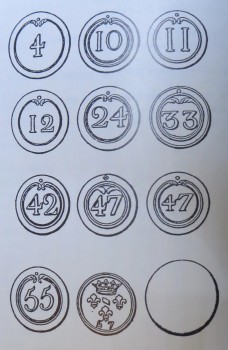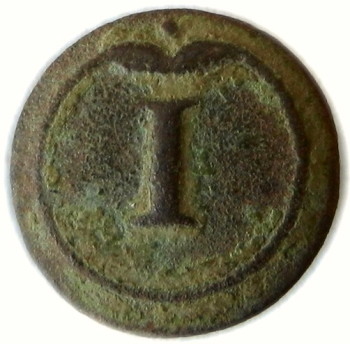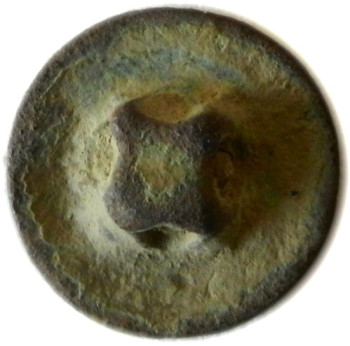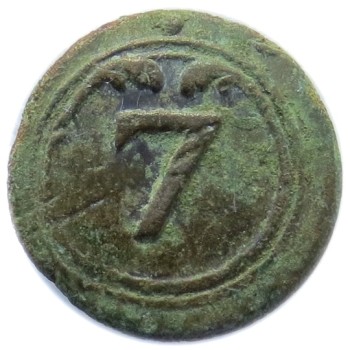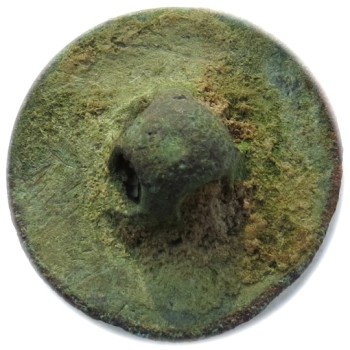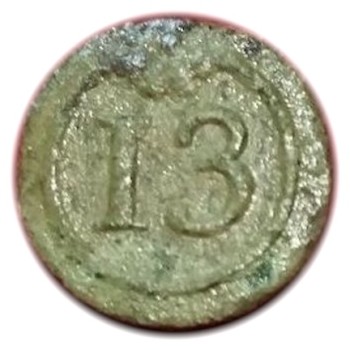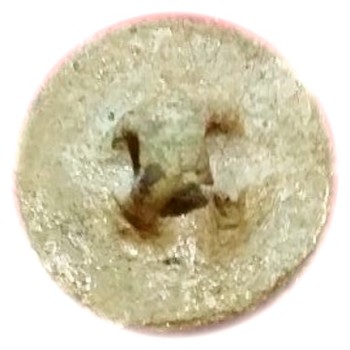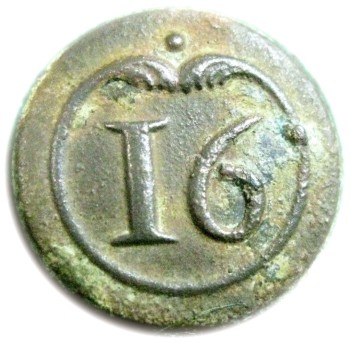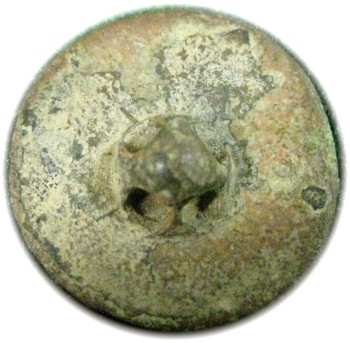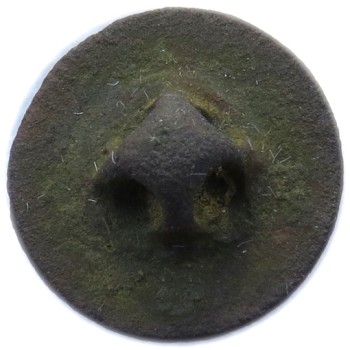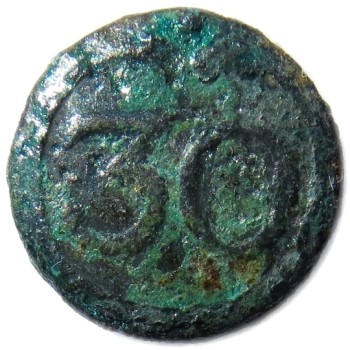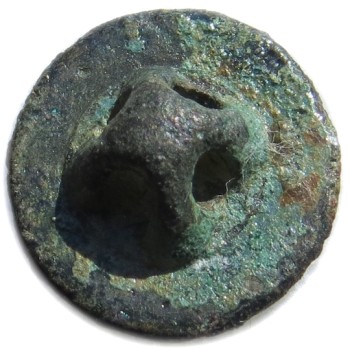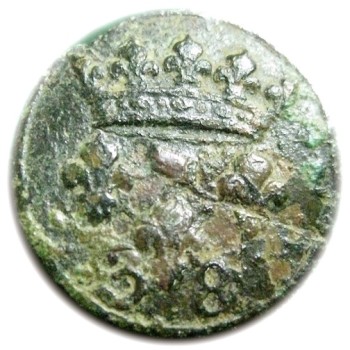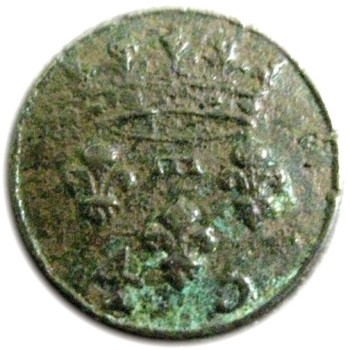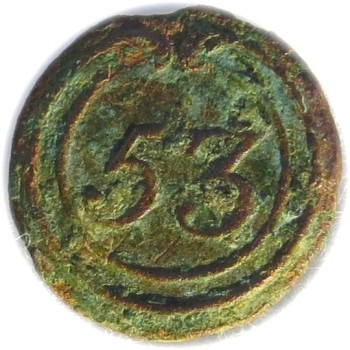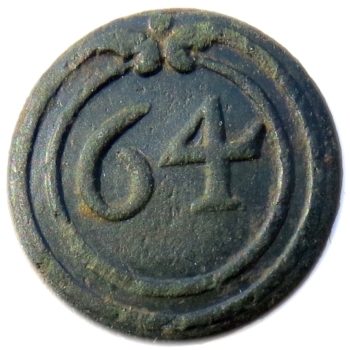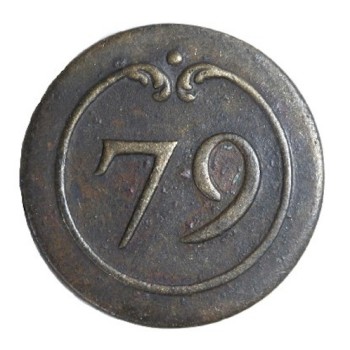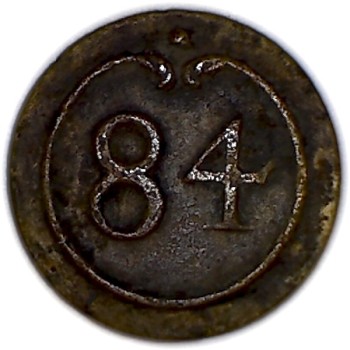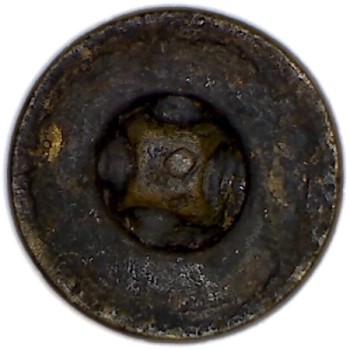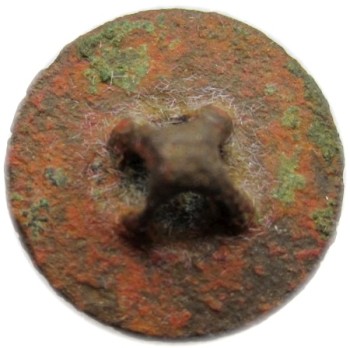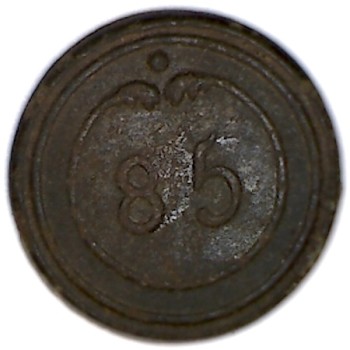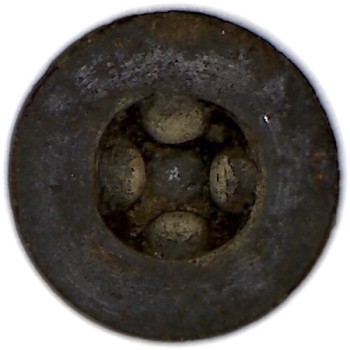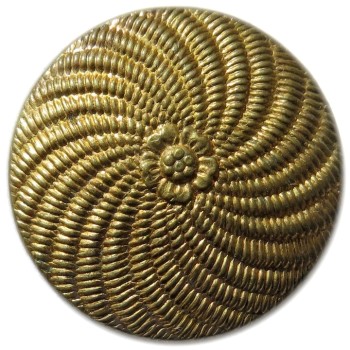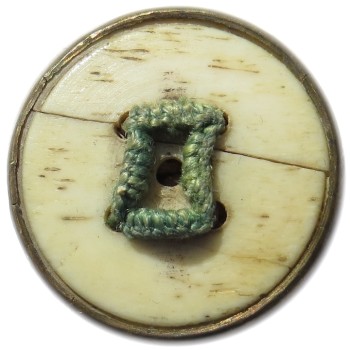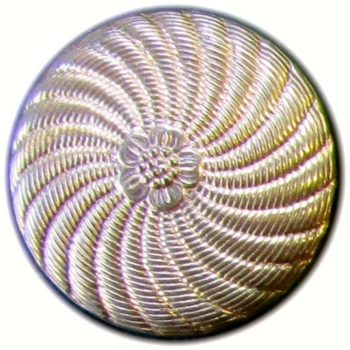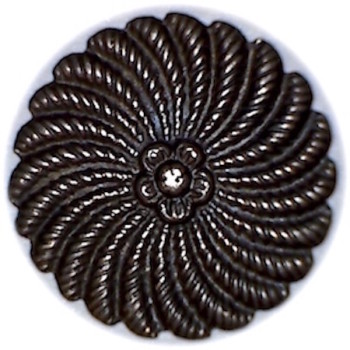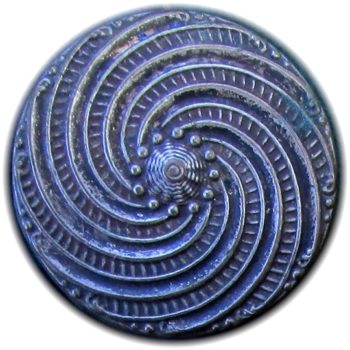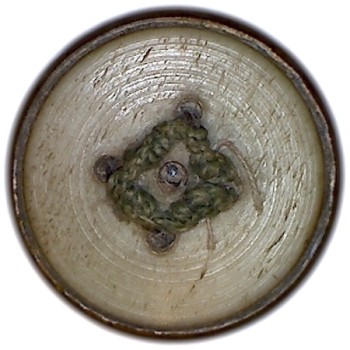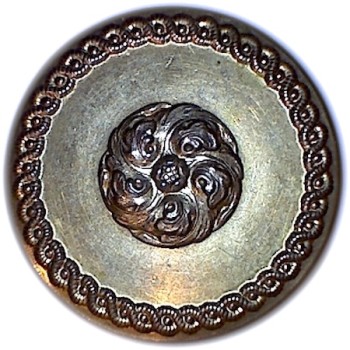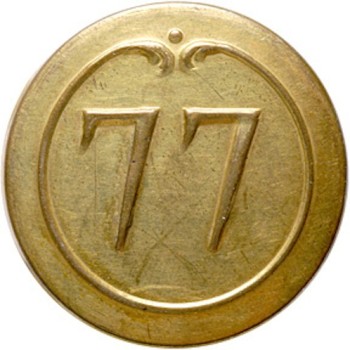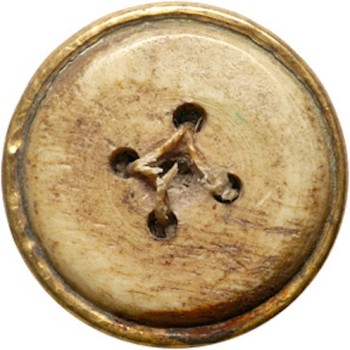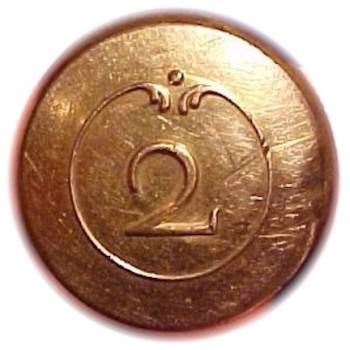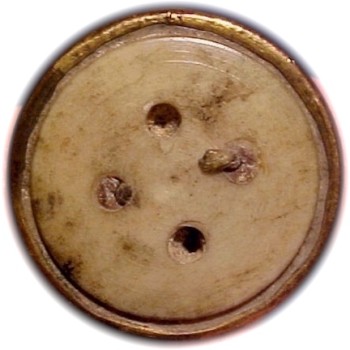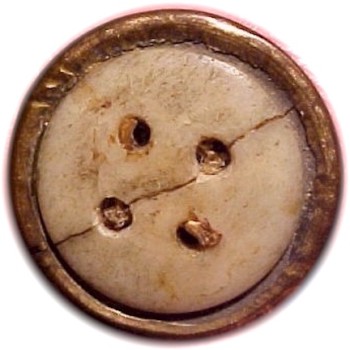The French Army
 1775 to 1794
1775 to 1794
Généraux Button
On the onset of the American Revolution the French did not take much faith or stock in helping the American Patriots. By the French Aristocrates this was viewed British internal politics. Because of class stratification, they viewed this as common citizens and newly landed Gentry trying to achieve certain equal rights within the British colonies. Once they were able to achieve various forms of equality they would promote themselves as British citizens. After three years of rebellion the French in their own war with the British revisited the benefit of helping the American Patriots and was finally backed by King Louis XVI’s of France in 1778. Louis XVI’s support was slow in the commitment of resources, but he did help finance a French standing army and authorized Naval support. Records show the French Court graciously authorized giving more than 20 million livres in cash, credit, and needed uniforms to help equip the Continental Army. American historians credit Dr. Benjamin Franklin for being the true motivating driving force which arranged support from the French Court. We will never know the series of trials and tribulations that Dr. Franklin had to resort to ultimately win favor under the political veil, but we know his Gentry connections were paramount to the Patriot Cause. We can reasonably say that his honorary degree bestowed from St. Andrews University in Scotland, and his scientific reputation which developed on a European world scale helped influence certain sympathetic Gentry to the Scot’s War in America. We know his scientific knowledge was celebrated by the Gentry class in Scotland, England, and France, but his Jacobite associations were key in winning America’s support in Scotland, England and France. So, a combination of diplomatic ties, Royalty associations, and membership in exclusive private Jacobite sympathy social clubs played a significant role in achieving his mission.
French military button collecting is very confusing, and is not straight forward with a units specific designation and actual geographical use of certain numbered buttons. The French standing Army went through several re-organizations which caused unit button numbers to be re-organized under other regiments during the Revolution. This causes an uncertainty of which unit played a role in certain geographical locations. Without reorganization records it is hard to pinpoint and assign actual dates of specific unit number assigned and when and what unit they were re-assigned under. Also, the length of time becomes an issue, and the time frame it lasted before the next re-organization.
From 1762 to 1786, they reorganized their command structure and Army seven times. During the American Revolution they reorganized it four times in 1775, 1776, 1779, and 1780. This strategic reorganization included adding new regiments, dropping names, or downgrading the serving troops with their numbers to provincial units. This effect caused button number to change frequently, and expand unit numbers used within a specific regiment. Meaning, in layman’s terms that some regiments may have used specific troop regiment numbered buttons on the outset, but under reorganization of troops a combination of specific number buttons were simultaneously reorganized under the umbrella of reorganization. It is reasonable to say, the French Army’s practice of reassigning unit numbers frequently was because the Generals were playing on a World Chessboard against Great Britain. They concentrated efforts on certain engagements which benefited the Macro picture of world theatre warfare.
Unfortunately to this day, French dug buttons that are even from verified known battlefield or encampment sites are unappreciated and undervalued. This could be a good thing for collectors of Revolutionary War buttons because they are needed to round out any button collection to tell the story properly.
To provide an avenue for button collectors who want to begin collecting French Regiment buttons used in the Revolutionary War, I am borrowing some pages from Marian L. Hurley’s book. She has cleverly organized the French unit numbers by the French Army’s reorganization years with an overall photo. This should help collectors distinguish which regiments were in use during any given year. Afterwards, I will list a sample of my own specimens in order to provide a clear understanding of the infantry of the line button with my usual brief description summary. This French section should be viewed as a Draft-in-Works until I get a handle on how this to properly present the information with a historical perspective.
For a more definitive and in-depth listing of reorganized infantry regiments, I recommend Marian L. Hurley’s, “A Collector’s guide to French Military Buttons of the American Revolution 1775-1783.”
1775 1776 1779
Troupes a Pied Troupes a Pied Troupes a Pied
Infanterie de Linge Infanterie de Linge Infanterie de Linge
Button Illustrations Courteous of Ed & Marian L. Hurley.
* The French Army*
1775 to 1784
Foot Troops
Infantry of the Line
************* **************** *************
************* *************
Button’s Regiment Number: 1st Infantry Regt. of the Line .
Button’s Use Date: 1762-1780
Name of Unit: Picardie Regiment.
Prescribed Issue: Enlisted Man’s Pattern.
Regulation Button Color: Yellow.
Metal Composition: Brass Button with Brass Turret Shank.
Button Size: 17mm. Cuff or Vest.
Stations & Engagements: The 1st infantry Regt. of the French Army was founded in 1479, and is one of the oldest active service regiments in the world, and one of the five oldest regiments in France. It is an offspring of the bands de Picardie under the Ancien Regime. In 1781, a detachment of this unit served as, “Ships Garrison” in the Yorktown Campaign. In 1780, the Colonel General assumed the number “1” and adopted a button with a stand of flags. Picardie took on the number “2”. It is assumed that buttons dug at Yorktown are from a Picardie detachment during the Revolutionary War. The button’s pattern depicts the regiment number, “1” in the center of a broken circle with touching iris ends. There is a small raised stipple above the center of the iris ends. The high relief pattern is set on a plain flat field.
The RJ Silverstein Collection.
Button’s Regiment Number: 7th Infantry Regt. of the Line .
Button’s Use Date: 1775-1776 / 1776-1779 / 1779-1782.
Name of Unit: Bourbonnais Regt. – 1775
Reorganized Unit: Piemont Regiment – 1776.
Reorganized Unit: Champagne Regt. 1779-1782
Prescribed Issue: Enlisted Man’s Pattern.
Regulation Button Color: Yellow.
Metal Composition: Brass Button with Brass Turret Shank.
Button Size: 17.92mm. Cuff or Vest.
Stations & Engagements: Champagne Regt. (White) has 1 Battalion in Martinique from January 1779 to July 1783. The Champagne Regt. in 1779, most likely didn’t receive any number 7 buttons in time for the Savannah campaign. Any brass buttons bearing the number 7 that were found in Yorktown were most likely older buttons from Bourbonnais Regt. that were still in use. In 1782, there was detachments in Rhode Island and Portsmouth New Hampshire.The button’s pattern depicts the regiment number, “7” in the center of a 2 Concentric Rings and an open circle with almost touching iris ends. There is a small raised stipple above the center of the iris ends. The high relief pattern is set on a plain flat field.
Dug at Williamsburg, VA
The RJ. Silverstein Collection.
Button’s Regiment Number: 11th Infantry Regt. of the Line.
Button Use Date: 1762-1775 / 1776-1791
Name of Unit: La Marine Regiment 1776-1779.
Name of Unit: Guyenne Regiment 1762-1775.
Prescribed Issue: Enlisted Man’s Pattern.
Regulation Button Color: Yellow 1762-1775, 1776-1779.
Regulation Button Color: White 1779-1791.
Metal Composition: Brass Button with Brass Turret Shank.
Button Size: 16.13mm cuff or vest.
Stations & Engagements: The button’s pattern depicts the regiment number, “11” in the center of a broken circle with almost touching iris ends. there is a small raised stipple above the center of the iris ends. The high relief pattern is set on a plain flat field.
Dug in Central Virginia.
RJ.Silverstein Collection
Button’s Regiment Number: 12th Infantry Regt. of the Line.
Button Use Date: 1777-1781
Name of Unit: Auxxerrois Regiment.
Prescribed Issue: Enlisted Man’s Pattern.
Regulation Button Color: Yellow.
Metal Composition: Brass Button with Brass Turret Shank.
Button Size: 16.90mm Cuff or Vest.
Stations & Engagements: Dug in Savannah Georgia. The 12th had a detachment at the siege of Savanah Georgia during September and October of 1779. In 1781, another detachment was part of the raid on Fort Prince of Wales, in Aug of 1781. The button’s pattern depicts the regiment number, “12” in the center of a broken circle with wide space between iris ends. There is a small raised stipple above the center of the iris ends. The high relief pattern is set on a plain flat field.
Dug in Savanah, Georgia.
The RJ Silverstein Collection.
Button’s Regiment Number: 13th Infantry Regt. of the Line.
Button Use Date: 1779 to 1783.
Name of Unit: Bourbonnais Regiment.
Prescribed Issue: Enlisted Man’s Pattern.
Regulation Button Color: White.
Metal Composition: Brass Button with Brass Turret Shank
Button Size: 18mm Cuff or Vest Size.
Stations & Engagements: Two Battalions in U.S. from May 2, 1780 to June 1783. Took part in Lloyd’s Neck raid in 1781. Siege of Yorktown Sept. to Oct. 1781. The button’s pattern depicts the regiment number, “13” in the center of a broken circle with touching iris ends. There is a small raised stipple above the center of the iris ends. The high relief pattern is set on a plain flat field.
Dug in Westchester, New York.
Button’s Regiment Number: 15th Infantry Regt. of the Line.
Button’s Use Date: May 31, 1776 to February 21, 1779
Name of Unit: Bourbonnais Regiment.
Infantry Number: Assumed the 13th.
Prescribed Issue: Enlisted Man’s Pattern.
Regulation Button Color: Yellow.
Metal Composition: Brass Button with Brass Turret Shank.
Button Size: 15.89mm. Cuff or Vest.
Stations & Engagements: The button’s pattern depicts the regiment number, “15” in the center of a broken circle with touching iris ends. there is a small raised stipple above the center of the iris ends. The high relief pattern is set on a plain flat field.
The RJ. Silverstein Collection.
Button’s Regiment Number: 16th Infantry Regt. of the Line.
Button Use Date: February 21, 1779-1781.
Name of Unit: Forez Regiment Prior to 1779.
Name of Unit: Agenois Regiment 1779 forward.
Infantry Number: 16 Assumed by Agenois 14th Regt. after 1779.
Prescribed Issue: Enlisted Man’s Pattern.
Regulation Button Color: White in 1779.
Regulation Button Color: Yellow after February 21, 1779.
Metal Composition: Brass Button with Brass Turret Shank.
Button Size: 16.89mm Cuff or Vest Size.
Stations & Engagements: Siege of Savanah in 1779, Florida May 1781. Siege at Yorktown, VA Sept-Oct. of 1781. The button’s pattern depicts the regiment number, “16” in the center of a broken circle with touching iris ends. There is a small raised stipple above the center of the iris ends. The high relief pattern is set on a plain flat field.
Button’s Regiment Number: 18th Infantry Regt. of the Line.
Button Use Date: America 1779-1781
Name of Unit: Gatinois Regiment.
Prescribed Issue: Enlisted Man’s Pattern.
Regulation Button Color: White
Metal Composition: Brass Button with Brass Turret Shank.
Button Size: 16.65mm. Cuff or Vest Size.
Stations & Engagements: There was one Battalion in Hati from October of 1777 to July of 1783. There was another Battalion in Martinique from 1776 to July of 1783. In America there was a detachment at the Siege of Savanah from Sept. to Oct. 1779. There was another detachment at the Siege of Pensacola Florida in May of 1781. Also, they were present at the Siege of Yorktown, Virginia in 1781. Prior this number was borne by Torraine Regiment (White) from 1762-1775.The button’s pattern depicts the regiment number, “18” in the center of a broken circle with touching iris ends. There is a small raised stipple above the center of the iris ends. The high relief pattern is set on a plain flat field.
Dug in Yorktown, VA.
The RJ Silverstein Collection.
Button’s Regiment Number: 19th Infantry Regt. of the Line.
Button Use Date: 1762-1775 / 1775-1776 / 1776-1791
Name of Unit: Aquitaine Regt. 1762-75.
Reorganized Unit: Dauphin Regt. 1775-75.
Reorganized Unit: Flandre Regt. 1776-91.
Prescribed Issue: Enlisted Man’s Pattern.
Regulation Button Color: Yellow.
Metal Composition: Brass Button with Brass Turret Shank.
Button Size: 16.28mm. Cuff or Vest.
Stations & Engagements: The button’s pattern depicts the regiment number, “19” in the center of a broken circle with touching iris ends. There is a small raised stipple above the center of the iris ends. The high relief pattern is set on a plain flat field.
The RJ Silverstein Collection.
Button’s Regiment Number: 30th Infantry Regt. of the Line.
Button Use Date: 1776-1786
Name of Unit: Dauphin Regiment 1776-1786.
Name of Unit: Assigned to Soissonnais 41st. Regiment 1776-1781
Prescribed Issue: Enlisted Man’s Pattern.
Regulation Button Color: Yellow.
Metal Composition: Brass Button with Brass Turret Shank.
Button Cuff Size: 16.22mm Cuff Size.
Stations & Engagements: There is no record of service in Dauphin Regt. in North America from 1775-1776. Any troops reorganized in Soissonnais 41st Regt. would have seen action on the Raid at Lloyd’s Neck in July of 1781, Siege of Yorktown, VA from Sept. to Oct. 1781. If buttons are dug at these location it would be reasonable to assume troops were using orig. issue uniforms and buttons. The button’s pattern depicts the regiment number, “30” in the center of a broken circle with almost touching iris ends. There is a small raised stipple above the center of the iris ends. The high relief pattern is set on a plain flat field.
Dug in Southbury, CT.
The RJ Silverstein Collection.
Button’s Regiment Number: 38 Conde Regiment.
Button Use Date: 1762 to 1775 / 1776-1779
Name of Unit: 38 Conde Regt. 1762-1775
Reorganized Unit: Artois Regiment 1775-75.
Reorganized Unit: Nivernais Regiment. 1776-79.
Reorganized Unit: Marechal de Turenne 1779-Post.
Prescribed Issue: Enlisted Man’s Pattern.
Regulation Button Color: Yellow
Metal Composition: Brass Button with Brass Turret Shank.
Button Size: 17mm. Cuff or Vest Size.
Stations & Engagements: The 38 Conde Regiment was one the few regiments that was allowed to wear the Prince’s Coat of Arms on their buttons. From 1762-1775 the Conde Regt. used the number 38. So, it stands to reason that any Conde buttons dug in the same vicinity as the later Rev War time 38th Infantry Regt. was apart of the same unit. This specimen along with another Prince Coat of Arms 45 Conde was dug here in Yorktown, VA. by Bill Brown in the early 1980’s.
Previously, the Bill Brown Collection.
Robert, I have personally dug some of these crown and fleurs-de-lis buttons near Yorktown and NW of Williamsburg carrying different numbers. Mention this because this specific design also carries the number 23, 24, 25, 36, 56, 57, 81, and 93; all are very rare and seldom encountered since they were all made well before the deployment of French troops to the Caribbean and later, New York, Rhode Island, Georgia and Virginia. – Bill Brown.
Button’s Regiment Number: 41st Infantry Regt. of the Line.
Button Use Date: Became 41st on May 3, 1776 to July 1791
Name of Unit: Soissonnais Regt. May 1780-July 1783
Prescribed Issue: Enlisted Man’s Pattern.
Regulation Button Color: Yellow.
Metal Composition: Brass Button with Brass Turret Shank.
Button Size: 17.23mm Cuff or Vest.
Stations & Engagements: Raid on Loyd’s Neck Bridge, New York July 1781, and then from Sept to Oct Siege of Yorktown, Virginia in 1781. The button’s pattern depicts the regiment number, “41” in the center of a broken circle with almost touching iris ends. There is a small raised stipple above the center of the iris ends. The high relief pattern is set on a plain flat field.
The RJ. Silverstein Collection.
Button’s Regiment Number: 45 Conde Regiment.
Button Use Date: 1775 to 1783
Name of Unit: Orleans Conde Regt.
Reorganized Unit: 38 Conde Regt.
Prescribed Issue: Enlisted Man’s Pattern.
Regulation Button Color: Yellow
Metal Composition: Brass Button with Brass Turret Shank.
Button Size: 17mm. Cuff or Vest Size.
Stations & Engagements: The Conde Regiment was one the few regiments who were allowed to wear the Coat of Arms of the Prince on their buttons. From 1762-1775 the Conde Regt. was numbered 38. So, it stands to reason that any buttons dug in the same vicinity as the 38th Infantry Regt. was one in the same. This specimen along with another Prince Coat of Arms 38 Conde was dug near Yorktown, VA. by Bill Brown in the early 1980’s.
Previously, the Bill Brown Collection.
Button’s Regiment Number: 47th Infantry Regt. of the Line.
Button Use Date: Royal Corps of Artillery 1767-1775
Name of Unit: Bretagne Regt.
Prescribed Issue: Officer’s Pattern.
Regulation Button Color: Yellow
Metal Composition: Brass Button with Brass Turret Shank.
Button Size: 18.94mm. Cuff or Vest Size.
Stations & Engagements: Since the Infantry Regiment has no official Revolutionary War service years, this button is thought to be older pattern’s that was still being worn by the Metropolitan Artillery troops. This button is thought to have been used by an officer from in Bretagne’s Regt. that served with another unit, possibly a small detachment. The button’s pattern depicts the regiment number, “47” in the center of 2 Concentric Rings. The inner circle being an open circle with almost touching iris ends. There is a small raised stipple above the center of the iris ends. The high relief pattern is set on a plain flat field.
The RJ. Silverstein Collection.
Button’s Regiment Number: 51st Infantry Regt. of the Line.
Button Use Date: 1776 to 1791
Name of Unit: Hainault Regt.
Prescribed Issue: Enlisted Man’s Pattern.
Regulation Button Color: Yellow
Metal Composition: Brass Button with Brass Turret Shank.
Button Size: 23mm. Coat Size.
Stations & Engagements: Originally the 33rd Regiment from 1762-75, and then the 40th until 1776. Both 33rd & 40th were prescribed White buttons. From 1776 to 1791 it reorganized into the 51st. This regiment had a detachment at the siege of Savannah, Sept through Oct of 1779. The button’s pattern depicts a the regiment number, “51” in the center of a broken circle with almost touching iris ends, There is a small raised stipple above the center of the iris ends. The high relief pattern is set on a plain flat field.
Dug near Savanah Georgia.
Button’s Regiment Number: 53rd Infantry Regt. of the Line.
Button Use Date: 1775-1776
Name of Unit: Royal Corps of Artillery.
Infantry Number: 53rd Artillery Regt.
Prescribed Issue: Enlisted Man’s Pattern.
Regulation Button Color: Yellow.
Metal Composition: Brass Button with Brass Turret Shank.
Button Size: 16.95mm Cuff or Vest.
Stations & Engagements: This unit was part of the Metropolitan Royal de l’ Artillerie battalions. This button’s pattern depicts the regiment number, “53” in the center of 2 Concentric Rings. The outer circle being open with almost touching iris ends. There is a small raised stipple above the center of the iris ends.. The high relief pattern is set on a plain flat field.
The RJ.Silverstein Collection.
Button’s Regiment Number: 56th Infantry Regt. of the Line.
Button Use Date: 1755 as 56th / 54th in 1757
Name of Unit: Conde Regt.
Prescribed Issue:
Regulation Button Color: Yellow
Metal Composition: Brass Button with Brass Turret Shank.
Button Cuff Size: 16mm. Cuff size.
Stations & Engagements: This unit originally formed in 1755, as the 56th, and then renumbered to the 54th in 1757. Most likely the troops kept their uniform and buttons after the re-organization since they were dug in America. The regiment saw action in New York and Charleston in 1776, Rhode Island in 1777-79. Also saw action in Connecticut. The unit was shipped to Halifax in September of 1782.
The RJ.Silverstein Collection.
Button’s Regiment Number: 64th Infantry Regt. of the Line.
Button Use Date: Royal Corps of Artillery 1776-1784
Name of Unit: Bretagne Regt.
Prescribed Issue: Officer’s Pattern.
Regulation Button Color: Yellow
Metal Composition: Brass Button with Brass Turret Shank.
Button Size: 16.92mm. Cuff or Vest Size.
Stations & Engagements: This unit was part of the Metropolitan Royal de l’ Artillerie battalions. The 47 was changed to 64 in 1776, and carried this number to the end of the war. There appears to be 4 known variation buttons using the number 64. One officer and 3 enlisted man’s patterns. The button’s pattern depicts the artillery regiment number, “64” in the center of 2 Concentric Rings. The outer circle being an open with almost touching iris ends. There is a small raised stipple above the center of the iris ends. The high relief pattern is set on a plain flat field.
The RJ. Silverstein Collection.
Button’s Regiment Number: 79th Infantry Regt. of the Line.
Button Use Date: Prior to 1776, Number assigned to 90th after 1776.
Name of Unit: Dillon Regiment.
Prescribed Issue: Officer’s Pattern- Gilded Copper, Enlisted Man’s-Brass.
Regulation Button Color: Yellow.
Metal Composition: Brass Button with Brass Turret Shank.
Button Coat Size: Approx. 23mm.
Button Cuff Size: Approx. 17mm.
Stations & Engagements: The 79th Regt. was assigned to the 90th Dillon Regt. prior to 1776. This number was not given to another regiment after that date. Any 79 numbered buttons found at Rev War sites are from prior to the reorganization by soldiers original issued uniforms. The button’s pattern depicts a the regiment number, “79” in the center of a broken circle with almost touching iris ends, There is a small raised stipple above the center of the iris ends. The high relief pattern is set on a plain flat field.
Button’s Regiment Number: 80th Infantry Regt. of the Line.
Button Use Date: 1781
Name of Unit: Lamarck Regiment.
Prescribed Issue: Enlisted Man’s Pattern.
Regulation Button Color: White.
Metal Composition: Brass Button with Brass Turret Shank.
Button Size: Approx. 18mm. Cuff or Vest Size.
Stations & Engagements: This was a German Regt. There was a detachment assigned to the Royal Deux-Ponts Regt. (104th) that was stationed in Rhode Island in June of 1781. The button’s pattern depicts a the regiment number, “80” in the center of a broken circle with touching iris ends, There is a small raised stipple above the center of the iris ends. The high relief pattern is set on a plain flat field.
Button’s Regiment Number: 84th Infantry Regt. of the Line.
Button Use Date: 1776 to 1779.
Name of Unit: La Marche Regiment.
Prescribed Issue: Enlisted Man’s Pattern.
Regulation Button Color: Yellow 1776 to 1779.
Button Color: Changed to White in 1779.
Metal Composition: Brass Button with Brass Turret Shank.
Button Size: Approx. 17mm. Cuff Size.
Stations & Engagements: In 1779, the number was assigned to the Conte Regiment. Troops had this number at Yorktown. No Record of Service in North America. The button’s pattern depicts the regiment number, “84” in the center of a broken circle with almost touching iris ends. There is a small raised stipple above the center of the iris ends. The high relief pattern is set on a plain flat field.
Dug at Yorktown, Va.
The Joe Cuevas Collection.
Button’s Regiment Number: 85th Infantry Regt. Of the Line.
Button Use Date: America 1780 to 1783.
Name of Unit: Saintonge Regiment.
Old Regt. Number: 68th Infantry Regt. from 1762-1775.
Prescribed Issue: Enlisted Man’s Pattern.
Regulation Button Color: White 1775-1779.
Regulation Button Color: Yellow 1779-1783
Metal Composition: Brass Button with Brass Turret Shank.
Button Size: 15.20mm. Cuff Size.
Stations & Engagements: In July of 1781, part of the Raid on Loyd’s Neck. From Set. to Oct. 1781, the Siege at Yorktown, Virginia. The button’s pattern depicts a the regiment number, “85” in the center of an Open Circle with almost touching iris ends, There is a small raised stipple above the center of the iris ends. The high relief pattern is set on a plain flat field.
Dug at Yorktown, Va.
RJ. Silverstein Collection.
Button’s Regiment Number: 85th Infantry Regt. Of the Line.
Button Use Date: In U.S. from 1780 to 1783.
Name of Unit: Saintonge Regiment.
Old Regt. Number: 68th Infantry Regt. from 1762-1775.
Prescribed Issue: Enlisted Man’s Pattern.
Regulation Button Color: White 1775-1779.
Regulation Button Color: Yellow 1779-1783
Metal Composition: Brass Button with Brass Turret Shank.
Button Size: Approx. 17mm. Cuff Size.
Stations & Engagements: This button’s pattern depicts the regiment number, “85” in the center of 2 Concentric Rings, and an Open Circle with almost touching iris ends. There is a small raised stipple above the center of the iris ends. The high relief pattern is set on a plain flat field. In July of 1781, part of the Raid on Loyd’s Neck. From Set. to Oct. 1781, the Siege at Yorktown, Virginia.
Dug at Yorktown, Va.
The Joe Cuevas Collection.
The French Army’s
Generals
&
Commissioned Officer’s
* 1775 to 1784 *
************* **************** *************
************* *************
Officially, officer’s dress buttons were prescribed as Yellow brass buttons. These are gilt or gold plated metal which were crimped over a wood or bone back. Records indicate that inspector generals and their staff used silver or a white metal. For field wear, all officers used cast buttons. The reverse either utilized cat gut cord or a heavy thread for the shank to be attached. There are 5 known types of officer’s button backs used. The first is a bone or wood round disc with five holes. The four outer holes would have the catgut cord or heavy thread as the shank. The obverse’s metal is then crimped over the bone or wood disc. The center hole present was the result of the manufacturing process of the bone or wood disc itself. The second design is a bone or wood disc with a wire shank going through the center hole. The third design is a two-piece button which has four holes in the back and either has catgut, wire, or a heavy thread used for the shank attachment. The fourth type is a round knotted thread back with the obverse’s metal crimped over its edges. The last is a round metal planchet. This has a stamped repousse metal obverse that is crimped over a metallic disk with a brazed shank. All officer’s coat buttons fall between 26mm. to 28mm. in size. All Officer’s cuff or vest buttons fall between 17mm to 19mm. in size.
************* **************** *************
************* *************
1775 to 1794 Généraux (General) Dress Button / 5 Petal 7 Anther Center Flower.
Button Use Date: 1775-1794.
Prescribed Issue: General of the French Army.
Regulation Button Color: Yellow.
Metal Composition: Gold Plated Brass Crimped over a Bone Disc.
Button Size: 26.98mm Coat Size.
Stations & Engagements: American & European Theatre.
Reverse: This is a Bone back with 5 holes. There are 5 types of officer’s button backs. This button is Type I: A bone back with 5 holes. The holes use either a cut gut cord or a heavy thread for the shank. The 5th or center hole is the result of the manufacturing process of the bone or wood disk. The yellow gold plated metal is crimped over a bone disc. All General’s buttons are bone or wood backs for dress, and cast for field wear.
The RJ. Silverstein Collection.
1775 to 1794 Généraux (General) Dress Button 5 Petal 13 Anther Center Flower.
Button Use Date: 1775-1794.
Prescribed Issue: General of the French Army.
Regulation Button Color: Yellow.
Metal Composition: Gold Plated Brass Crimped over a Bone Disc.
Button Size: 27.00mm Coat Size.
Stations & Engagements: American & European Theatre.
Reverse: This is a Bone back with 5 holes. There are 5 types of officer’s button backs. This button is Type I: A bone back with 5 holes. The holes use either a cut gut cord or a heavy thread for the shank. The 5th or center hole is the result of the manufacturing process of the bone or wood disk. The yellow gold plated metal is crimped over a bone disc. All General’s buttons are bone or wood backs for dress, and cast for field wear.
The David Gates Collection.
1775 to 1794 Généraux (General) Field Wear Button / 5 Petal Flower Dome Stigma.
Button Use Date: 1775-1794.
Prescribed Issue: Commissioned Officer, General of the French Army.
Regulation Button Color: White
Metal Composition: White Cast Metal: Silver.
Button Size: 17mm Cuff Size.
Stations & Engagements: American & European Theatre.
Reverse: A one piece button with a loop shank.
1775 to 1794 Généraux (General) Dress Button / 12 Stipple Dome Center.
Button Use Date: 1775-1794.
Prescribed Issue: General of the French Army.
Regulation Button Color: Yellow.
Metal Composition: Silver’d Brass Crimped over a Wood Disc.
Button Size: 28.01mm Coat Size.
Stations & Engagements: American & European Theatre.
Reverse: This is a Wood back with 4 holes. There are 5 types of officer’s button backs. This button is Type I: A wood back with 4 holes. The holes use either a cut gut cord or a heavy thread for the shank. The yellow gold plated metal is crimped over a wood disc. All General’s buttons are bone or wood backs for dress, and cast for field wear.
The David Gates Collection.
1775 to 1794 Généraux (General) Dress Button / 12 Stipple Cone Center.
Button Use Date: 1775-1794.
Prescribed Issue: General of the French Army.
Regulation Button Color: Yellow.
Metal Composition: Gilt Brass Crimped over a Wood Disc.
Button Size: 28.00mm. Coat Size.
Stations & Engagements: American & European Theatre.
Reverse: This is a wood back with 4 holes. There are 5 types of officer’s button backs. This button is Type I: A wood back with 4 holes. The holes use either a cut gut cord or a heavy thread for the shank. The yellow gold plated metal is crimped over a wood disc. All General’s buttons are bone or wood backs for dress, and cast for field wear.
The David Gates Collection.
1775 to 1794 Aide de Camp Dress Button.
Button Use Date: Sept 2, 1775-1794.
Prescribed Issue: Commissioned Officer to Staff.
Regulation Button Color: White
Metal Composition: Plated White Metal Crimped over a Bone Disc.
Button Size: 26.01mm Coat Size.
Stations & Engagements: American & European Theatre.
Reverse Button Analysis: This button is Type I: A bone back with 5 holes. The 4 outer holes use a cut gut cord or a heavy thread for the shank. The 5th or center hole is the result of the manufacturing process of the bone or wood disk. The plated metal is crimped over a bone disc. All General Staff Officer’s buttons are bone or wood backs for dress, and cast for field wear.
1775 to 1794 French Inspector Generals & Staff Dress Button
Button Use Date: 1775-1794.
Prescribed Issue: Commissioned Officer, General of the French Army.
Regulation Button Color: Yellow.
Metal Composition: Gold Plated Metal Crimped over A Wood Disc.
Button Size: 26.01mm Coat Size.
Stations & Engagements: American & European Theatre.
Reverse Button Analysis: This button is Type I: A wood back with 4 holes. The holes use either a cut gut cord or a heavy thread for the shank. The yellow gold plated metal is crimped over a bone disc. All generals buttons are bone or wood backs for dress, and cast for field wear.
Button’s Regiment Number: 77th Infantry Regt. of the Line.
Button Use Date: 1776 – 1786
Name of Unit: Beaujolais Regiment.
Prescribed Issue: Commissioned Officer’s Button.
Regulation Button Color: Yellow.
Metal Composition: Gold Plated Metal Crimped over Bone Disc.
Button Size: Approx. 26mm. Coat Size.
Reverse Button Analysis: This is a bone back with 5 holes. There are 5 types of officer’s button backs. This button is Type I: A bone back with 5 holes. The holes use either a cut gut cord or a heavy thread for the shank. The yellow gold plated metal is crimped over a bone disc.
Stations & Engagements: The button’s pattern depicts a the regiment number, “77” in the center of a broken circle with almost touching iris ends, There is a small raised stipple above the center of the iris ends. The high relief pattern is set on a plain flat field.
Button’s Regiment Number: 80th Infantry Regt. of the Line.
Button Use Date: 1781.
Name of Unit: Lamarck Regiment.
Prescribed Issue: Commissioned Officer’s Button.
Regulation Button Color: Yellow.
Metal Composition: Gold Plated Metal Crimped over a Wood Disc.
Button Size: Approx. 17mm. to 19mm. Cuff or Vest Size.
Reverse Button Analysis: This button is Type I: A wood back with 5 holes. The holes use either a cut gut cord or a heavy thread for the shank. The yellow gold plated metal is crimped over a wood disc.
Stations & Engagements: This was a German Regt. There was a detachment assigned to the Royal Deux-Ponts Regt. (104th) that was stationed in Rhode Island in June of 1781. The button’s pattern depicts a the regiment number, “80” in the center of a broken circle with almost touching iris ends, There is a small raised stipple above the center of the iris ends. The high relief pattern is set on a plain flat field.
Button’s Regiment Number: 2nd Infantry Reg. of the Line.
Button Use Date: 1762-1776 / 1776-80 / 1781
Name of Unit: Champagne Regt. 1762-1776
Reorganized Unit: Provence Regt. 1776-1780 when #2 assigned to Picardie.
Prescribed Issue: Commissioned Officer’s Button.
Regulation Button Color: Yellow (Always for Officers).
Metal Composition: Gold Plated Metal Crimped over a Bone Disc.
Button Size: 23mm. Coat Size.
Reverse Button Analysis: This is a bone back with 4 holes. This button is Type I: A bone back with 4 holes. The holes use either a cut gut cord or a heavy thread for the shank. The yellow gold plated metal is crimped over a wood disc. All officer’s buttons are bone or wood backs for dress, and cast for field wear.
Stations & Engagements: A detachment of Picardie served as “Ships Garrison” during the siege of Yorktown in 1781. Collector’s note, when they say, “Ships Garrison” it is a reference to infantry troops who are stationed aboard ships, but not part of the ship’s company. The button’s pattern depicts a the regiment number, “2” in the center of a broken circle with almost touching iris ends, There is a small raised stipple above the center of the iris ends. The high relief pattern is set on a plain flat field.
Button’s Regiment Number: 14th Infantry Regt. of the Line.
Button Use Date: 1777 to 1783.
Name of Unit: Agenois Regiment.
Prescribed Issue: Commissioned Officer’s Button.
Regulation Button Color: Yellow.
Metal Composition: Gold Plated Metal Crimped over Bone Disc.
Button Cuff Size: 17mm Cuff Size.
Reverse Button Analysis: This is a bone back with 4 holes. This button is Type I: A bone back with 4 holes. The holes use either a cut gut cord or a heavy thread for the shank. The yellow gold plated metal is crimped over a wood disc. All officer’s buttons are bone or wood backs for dress, and cast for field wear.
Stations & Engagements: A detachment was at the siege of Pensacola, and siege of Savannah in 1779. Also, siege of Yorktown, Virginia from Sept to October in 1781. The button’s pattern depicts a the regiment number, “14” in the center of a broken circle with almost touching iris ends, There is a small raised stipple above the center of the iris ends. The high relief pattern is set on a plain flat field.
